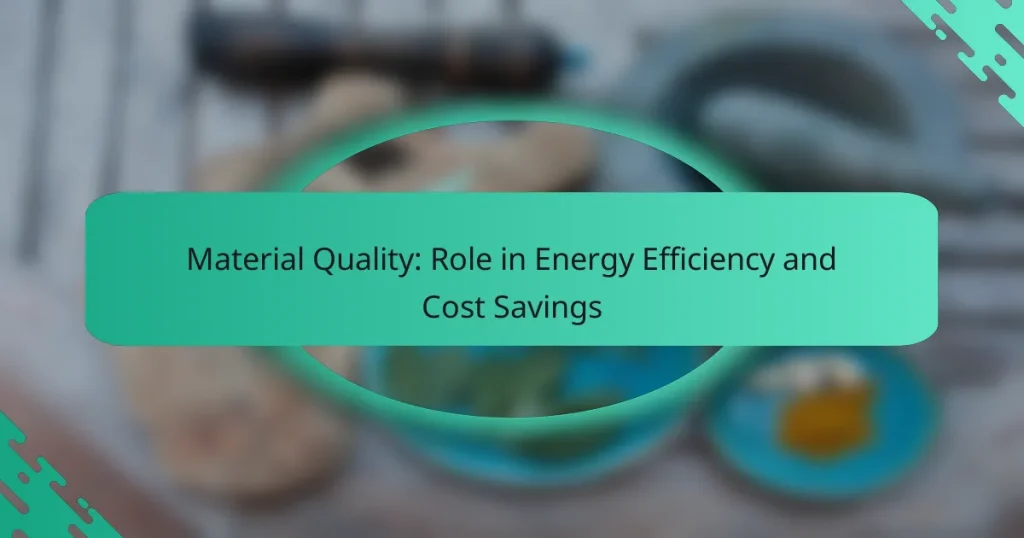Material quality plays a crucial role in enhancing energy efficiency within homes, directly affecting how well structures maintain desired temperatures. By utilizing high-quality materials, homeowners can achieve substantial cost savings on energy bills, as these materials minimize energy loss and improve climate control. Investing in durable and efficient materials not only reduces maintenance costs but also increases property value over time.

How does material quality impact energy efficiency in homes?
Material quality significantly influences energy efficiency in homes by determining how well a structure retains heat or cool air. High-quality materials can lead to substantial cost savings on energy bills by minimizing energy loss and improving overall climate control.
High-quality insulation reduces energy loss
Insulation plays a crucial role in maintaining indoor temperatures by reducing energy loss. High-quality insulation materials, such as spray foam or fiberglass, can provide better thermal resistance, which helps keep homes warm in winter and cool in summer.
When selecting insulation, consider factors like R-value, which measures thermal resistance. Aim for insulation with higher R-values for your climate zone, as this can lead to significant energy savings over time.
Durable windows improve thermal performance
Windows are a major source of energy loss in homes, and investing in durable, energy-efficient windows can enhance thermal performance. Double or triple-pane windows with low-emissivity (Low-E) coatings can significantly reduce heat transfer.
When choosing windows, look for those with a high Energy Star rating, which indicates better energy efficiency. Proper installation is also essential; even the best windows can underperform if not installed correctly.
Energy-efficient roofing materials enhance climate control
The choice of roofing materials can greatly affect a home’s energy efficiency. Energy-efficient roofing options, such as cool roofs or reflective shingles, help reduce heat absorption, keeping homes cooler and decreasing air conditioning costs.
Consider materials that meet local energy codes and reflect sunlight effectively. Additionally, regular maintenance of roofing can prevent leaks and prolong the lifespan of the roof, further contributing to energy savings.

What are the cost savings associated with high-quality materials?
High-quality materials can lead to significant cost savings over time by enhancing energy efficiency, reducing maintenance expenses, and increasing property value. Investing in durable, efficient materials often results in lower utility bills and fewer replacements, making it a financially sound choice.
Lower utility bills from improved energy efficiency
Using high-quality materials can greatly enhance a building’s energy efficiency, leading to lower utility bills. For instance, energy-efficient windows and insulation can reduce heating and cooling costs by up to 30% compared to standard options.
When selecting materials, consider those with high energy ratings, such as ENERGY STAR certified products. These materials not only save money but also contribute to a more sustainable environment.
Longer lifespan reduces replacement costs
High-quality materials typically have a longer lifespan, which minimizes the frequency and cost of replacements. For example, premium roofing materials can last 20-50 years, while cheaper alternatives may need replacement within a decade.
Investing in durable materials means fewer disruptions and lower long-term costs. Always weigh the initial investment against potential savings over time to make informed decisions.
Increased property value from quality upgrades
Upgrading to high-quality materials can significantly increase property value. Homes with energy-efficient features and durable finishes often appraise higher and attract more buyers, leading to a better return on investment.
Consider focusing on key areas such as kitchen and bathroom renovations with quality fixtures and finishes. These upgrades not only enhance aesthetics but also appeal to potential buyers, making your property more competitive in the market.

Which materials are best for energy efficiency?
Materials that enhance energy efficiency typically include high-performance insulation, advanced window designs, and reflective roofing options. These materials not only improve thermal performance but also contribute to significant cost savings on energy bills.
Spray foam insulation for superior sealing
Spray foam insulation is known for its excellent sealing properties, filling gaps and cracks that traditional insulation may miss. This material expands upon application, creating an airtight barrier that minimizes heat transfer and air leaks.
When considering spray foam, look for products that meet relevant building codes and energy efficiency standards. While the initial cost may be higher than other insulation types, the long-term energy savings can offset the investment significantly.
Triple-pane windows for optimal insulation
Triple-pane windows consist of three layers of glass, providing superior insulation compared to single or double-pane options. The additional layer of glass, combined with gas fills between panes, reduces heat loss and enhances soundproofing.
Investing in triple-pane windows can be particularly beneficial in regions with extreme temperatures. While they may come with a higher upfront cost, the energy savings and increased comfort can make them a worthwhile choice over time.
Reflective roofing materials for heat management
Reflective roofing materials are designed to reflect sunlight, reducing heat absorption in buildings. This helps maintain cooler indoor temperatures, especially in warmer climates, leading to lower air conditioning costs.
When selecting reflective roofing, consider materials such as metal or specially coated shingles that meet Energy Star standards. These options can significantly enhance energy efficiency and prolong the lifespan of your roof by minimizing thermal stress.

What are the local regulations affecting material choices?
Local regulations significantly influence material choices by establishing standards for energy efficiency and safety. Compliance with these regulations can lead to cost savings and improved energy performance in buildings.
Building codes in California mandate energy-efficient standards
California’s building codes require that all new constructions meet strict energy efficiency standards. These codes are designed to reduce energy consumption and greenhouse gas emissions, often mandating the use of high-performance insulation, energy-efficient windows, and advanced HVAC systems.
For example, the California Title 24 standards specify minimum efficiency ratings for various building components. Builders must ensure that their materials not only comply with these regulations but also contribute to overall energy savings, which can lead to lower utility bills for homeowners.
Permits required for installation of specific materials
In California, certain materials require permits before installation, particularly those that impact energy efficiency or structural integrity. For instance, the use of specific insulation types or solar panels often necessitates obtaining a building permit to ensure compliance with local codes.
Homeowners and contractors should check with local building departments to understand the permit process and any associated fees. Failing to secure the necessary permits can result in fines or the need for costly modifications after installation.

How can homeowners assess material quality?
Homeowners can assess material quality by examining certifications, warranties, and customer feedback. These factors provide insights into the durability, energy efficiency, and overall performance of materials used in home construction or renovation.
Look for energy performance certifications
Energy performance certifications indicate that materials meet specific efficiency standards. Look for labels such as ENERGY STAR or similar local certifications that verify energy-saving capabilities. These certifications can help homeowners choose products that reduce energy consumption and lower utility bills.
When evaluating materials, consider those that have been tested under recognized standards. For example, insulation products with R-value ratings can help determine their effectiveness in thermal resistance.
Check for manufacturer warranties
Manufacturer warranties are a strong indicator of material quality and reliability. A longer warranty period often reflects the manufacturer’s confidence in their product’s durability and performance. Homeowners should look for warranties that cover both defects and performance over time.
Be cautious of warranties that have many exclusions or require specific installation methods. Understanding the terms can help avoid potential pitfalls if issues arise later.
Evaluate customer reviews and ratings
Customer reviews and ratings provide real-world insights into material performance and satisfaction. Homeowners should read reviews on multiple platforms to get a balanced view of the product’s strengths and weaknesses. Look for patterns in feedback regarding durability, ease of installation, and energy efficiency.
Pay attention to reviews from customers in similar climates or situations, as their experiences may be more relevant. A high rating from a significant number of users can indicate a reliable choice for your home improvement projects.

What are the emerging trends in energy-efficient materials?
Emerging trends in energy-efficient materials focus on sustainability, performance, and cost-effectiveness. Innovations include advanced insulation, smart materials, and eco-friendly alternatives that enhance energy efficiency while reducing overall costs.
Advanced Insulation Technologies
Advanced insulation technologies are crucial for improving energy efficiency in buildings. Materials such as aerogels and vacuum insulation panels provide superior thermal resistance, allowing for lower energy consumption in heating and cooling. These materials can reduce energy costs by up to 30% compared to traditional insulation.
When selecting insulation, consider factors like R-value, which measures thermal resistance, and the material’s environmental impact. High-performance insulation may have a higher upfront cost but can lead to significant long-term savings.
Smart Materials and Systems
Smart materials, such as phase change materials (PCMs) and responsive polymers, adapt to environmental changes to optimize energy use. For example, PCMs absorb and release heat, helping to maintain comfortable indoor temperatures without excessive energy consumption.
Integrating smart systems with building management can further enhance energy efficiency. Automated controls can adjust heating, cooling, and lighting based on occupancy and weather conditions, leading to additional savings.
Eco-Friendly Alternatives
Eco-friendly materials, including recycled and bio-based products, are gaining traction in the construction industry. These materials not only reduce waste but also lower the carbon footprint of buildings. Examples include recycled steel, bamboo, and hempcrete.
When choosing eco-friendly alternatives, verify certifications such as LEED or BREEAM, which ensure compliance with sustainability standards. While these materials may have varying costs, they often provide long-term savings through energy efficiency and reduced environmental impact.


